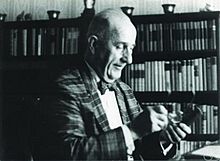Carl Ludwig Siegel facts for kids
Quick facts for kids
Carl Ludwig Siegel
|
|
|---|---|

Carl Ludwig Siegel in 1975
|
|
| Born | 31 December 1896 |
| Died | 4 April 1981 (aged 84) |
| Alma mater | University of Göttingen |
| Known for | Brauer–Siegel theorem Siegel modular form Siegel modular variety Siegel zero Smith–Minkowski–Siegel mass formula Thue–Siegel–Roth theorem Siegel's theorem on integral points Siegel domain |
| Awards | Wolf Prize (1978) |
| Scientific career | |
| Fields | Mathematics |
| Institutions | Johann Wolfgang Goethe-Universität Institute for Advanced Study |
| Doctoral advisor | Edmund Landau |
| Doctoral students |
|
Carl Ludwig Siegel (born December 31, 1896 – died April 4, 1981) was a brilliant German mathematician. He was especially good at a type of math called analytic number theory, which deals with whole numbers using tools from calculus. He is famous for his work on important math problems, including the Thue–Siegel–Roth theorem and the Smith–Minkowski–Siegel mass formula. Many people consider him one of the most important mathematicians of the 20th century.
Another famous mathematician, André Weil, even called Siegel the greatest mathematician of the first half of the 1900s. Atle Selberg, another math expert, said that Siegel did things that seemed impossible, even after he had already solved them!
Biography
Carl Ludwig Siegel was born in Berlin, Germany. In 1915, he started studying mathematics, astronomy, and physics at the Humboldt University in Berlin. His teachers included famous scientists like Max Planck and Ferdinand Georg Frobenius. Their influence made young Siegel decide to focus on number theory, which is a branch of mathematics that studies whole numbers and their properties.
Siegel also taught many students who became famous mathematicians themselves. One of his best-known students was Jürgen Moser, who helped create KAM theory. This theory is very important in understanding chaos theory, which explains how small changes can lead to big, unpredictable results. Another notable student was Kurt Mahler, who also worked on number theory.
During World War I, Siegel was against fighting. In 1917, he received support from his teacher Edmund Landau during a difficult time. After the war ended, he went to the University of Göttingen to study more with Landau, who became his PhD supervisor in 1920. Siegel stayed in Göttingen as a teaching assistant and researcher, and he published many important discoveries during this time.
In 1922, he became a professor at the Johann Wolfgang Goethe-Universität in Frankfurt am Main. Siegel strongly disagreed with the Nazi party's ideas. He was good friends with other professors like Ernst Hellinger and Max Dehn and used his influence to help them. In Frankfurt, he joined a special seminar where they studied the history of mathematics by reading original old math books.
In 1936, he gave a major speech at the International Congress of Mathematicians in Oslo. In 1938, he returned to Göttingen. However, in 1940, he moved to the United States through Norway to join the Institute for Advanced Study in Princeton, New Jersey. He had visited Princeton before in 1935. After World War II, he returned to Göttingen in 1951 and worked as a professor until he retired in 1959. In 1968, he was chosen as a foreign member of the U.S. National Academy of Sciences.
His Amazing Work
Siegel's work in number theory, Diophantine equations (which are equations where you only look for whole number solutions), and celestial mechanics (the study of how planets and stars move) earned him many awards. In 1978, he received the first Wolf Prize in Mathematics. This is one of the most respected awards in math. When the prize committee was deciding who to give the award to, they considered Siegel and Israel Gelfand as the top choices. They ended up sharing the prize.
Siegel's work covered many areas of math. His theorem about the number of integer points of curves (points on a graph where both x and y are whole numbers) was very important. It was a big step forward in solving Diophantine equations when not much was known about them. He also worked on L-functions and quadratic forms, which are special kinds of math expressions.
Siegel was also very interested in the history of mathematics. He used his knowledge of past discoveries to help him with his own work, like the Riemann–Siegel formula. He once said that when someone first discovered a simple math rule, "It pleased the dear Lord." This shows how much he appreciated the beauty of mathematical discoveries.
What He Wrote
Here are some of the books and papers Carl Ludwig Siegel wrote:
- Transcendental numbers, 1949
- Analytic functions of several complex variables, 1949
- Gesammelte Werke (Collected Works), 3 volumes, 1966
- With Jürgen Moser Lectures on Celestial mechanics, 1971
- On the history of the Frankfurt Mathematics Seminar, 1978/9
- Transzendente Zahlen, 1967
- Vorlesungen über Funktionentheorie, 3 volumes
- Symplectic geometry, 1943
- Advanced analytic number theory, 1980
- Lectures on the Geometry of Numbers, 1989
See also
 In Spanish: Carl Ludwig Siegel para niños
In Spanish: Carl Ludwig Siegel para niños
- Bourget's hypothesis
- Siegel's conjecture
- Siegel's number
- Siegel disk
- Siegel's lemma
- Siegel upper half-space
- Siegel–Weil formula
- Siegel parabolic subgroup
- Smith–Minkowski–Siegel mass formula
- Riemann–Siegel formula
- Riemann–Siegel theta function
- Siegel–Shidlovsky theorem
- Siegel–Walfisz theorem
- Siegel's theorem (Minkowski–Hlawka theorem)
Images for kids


